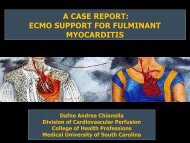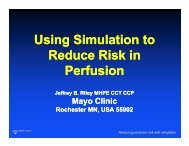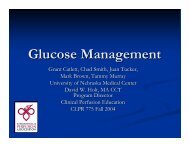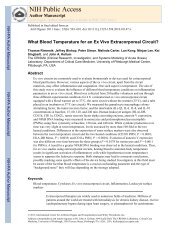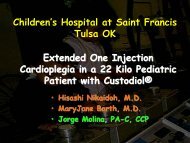PowerPoint Presentation (PDF) - Perfusion.com
PowerPoint Presentation (PDF) - Perfusion.com
PowerPoint Presentation (PDF) - Perfusion.com
Create successful ePaper yourself
Turn your PDF publications into a flip-book with our unique Google optimized e-Paper software.
H1N1 FLU PANDEMIC THE NOVA SCOTIA EXPERIENCE<br />
EXTRACORPOREAL MEMBRANE OXYGENATION/TAKING A HIT<br />
STEPHEN G. MORRISON<br />
SATURDAY SEPTEMBER 10, 2009
QEII HEALTH SCIENCES<br />
CENTER
INCIDENCE OF H1N1 IN CANADA<br />
Cases of H1N1 continue to be reported in Nova Scotia. There have been 17<br />
hospitalized cases and one death associated with the HINI virus since the outbreak<br />
started on April 26.<br />
As of 1 August, 2009, a total of 1,315 hospitalized cases and 227 cases admitted to<br />
an intensive care unit (ICU) had been reported so far to the Public Health Agency of<br />
Canada. This week, three deaths were reported for a total of 60 deaths since the<br />
beginning of the pandemic. The peak period of hospitalizations was observed during<br />
the first 3 weeks of June.
Message from The Department Of Health<br />
If You Woke up This Morning Looking Like This<br />
Don’t Go To Work
• 25 Year old female presented to<br />
<strong>com</strong>munity medical center, June 28. 2009<br />
• C/O dry cough, fever, chills, general<br />
malaise, shortness of breath<br />
• Duration of symptoms six days
Past medical history<br />
• Gastro-esophageal reflux<br />
• Endometriosis<br />
• Smokes .5 packs cigarettes day<br />
• Allergies to Azithromycin<br />
• Height- 170cm<br />
• Weight- 90 Kg<br />
• BSA-2.06 ms
• Chest x-ray showed bi-lateral infiltrates in<br />
all lung segments<br />
• Started on Erythromycin 1gm<br />
• Tami-flu 75 mg x 10 days<br />
• Throat swabs taken for Dx of H1N1<br />
• She claimed she was exposed to a co-<br />
worker positive for H1N1
• Clinically became more short of breath<br />
• Hypoxemic, decreasing arterial O2<br />
saturations to 82% on 100 % O2<br />
• Transferred to Regional Hospital
• Following initial assessment<br />
• Transferred to Medical Surgical Intensive Care<br />
unit<br />
• Sedated, intubated/ventilated, received paralytic<br />
drug Nimbex 20 mg IV<br />
• Ventilator settings, g, Fi02 0.7 (Sechrist Blender),<br />
peep 12 cm/H20, respiratory rate 20 bpm,<br />
• Arterial O2 saturation improved to 91%<br />
• Nitric oxide initiated at 5 parts per million<br />
increased to 70 PPM<br />
• Discontinued day 2, felt to be ineffective
• Throat swabs confirmed the pt. positive for<br />
H1N1<br />
• Also Dx with <strong>com</strong>munity acquired bacterial super<br />
infection, methecillin resistant staphylococcus<br />
aureus<br />
• Repeat x-ray showed persistent bi-lateral<br />
infiltrates t with progression<br />
• Cardiac function as assessed by ultra sound<br />
showed normal left and right ventricular and<br />
atrial function with slight mitral valve<br />
regurgitation
X-ray June 2nd
• She deteriorated that evening<br />
• Arterial Oxygen saturation declined to 52% on<br />
Fio2 of 1.0<br />
• Arterial blood gas obtained, PaO2 32 mmhg,<br />
CO2 43 mmhg, hemoglobin 125 g/l<br />
• Respiratory initiated hand bagging with 100%<br />
O2<br />
• Saturation rose to 88%<br />
• PaO2 56 mmhg
• Cardiac surgery consulted<br />
• ECMO protocol initiated<br />
• Team arrived<br />
• Surgeon prepped groins for ECMO cannulation<br />
• <strong>Perfusion</strong> arrived with primed, de-aired ECMO circuit<br />
• 3/8/3/8 inch Carmeda coated (heparin coated) tubing<br />
• 32 ml Rotoflow cone (Bioline coated)<br />
• Quadrox D oxygenator, (Bioline coated)<br />
• Biiomedicus, Minneapolis, Minesota 540 console<br />
• Biomedicus Bio Cal 370 heater cooler
• 5000 unit bolus of heparin (hepalean) ea given to<br />
patient, prior to initating ECMO<br />
• Cannulation of right internal jugular via seldinger<br />
technique, with an uncoated 17 French DLP<br />
venous cannula (Medtronic)<br />
• Left groin cannulated with an uncoated 17<br />
French DLP arterial cannula (Medtronic)<br />
• Could not pass a venous cannula<br />
• Cannulas clamped distally connected to<br />
crystalloid (Normosol-R) primed circuit
• ECMO initiated<br />
• Flow of 2.8 LPM achieved<br />
• Fi02 1.0, sweep gas of 4.0 liters,<br />
• Arterial oxygen saturation 98% on oxysat monitor, CDI 100<br />
• Negative pressure -56 mmhg (measured pre Rotoflow cone), with<br />
chatter noted in lines<br />
• To bring down the inlet pressure, Voluven 250 mls given , pressure<br />
dropped to – 27 mmhg<br />
• ACT drawn with results of 360 seconds<br />
• Heparin infusion started at 1600 units per hour<br />
• ACT’s remained in the 160-210 sec range with minor adjustments of<br />
heparin drip. 1500-1800 1800 units per hour<br />
• ACT’s drawn every hour
• In order to achieve a negative fluid balance of 1 liter in<br />
24 hrs<br />
• Bolus of lasix 40 mg was given and a drip started<br />
• 100 mls per hour was taken off via hemoconcentrator<br />
• A Propofol infusion was started at 400 mg/hr, later<br />
decreased to 200 mg/hr<br />
• Voluven was needed at regular intervals to keep<br />
negative pressure less than -30 mmhg<br />
• Order by physician was to give voluven 250 mls Prn.<br />
• Negative fluid balance was never achieved
• To improve venous drainage and<br />
increase ECMO flows<br />
• Second venous cannula ( 21 French<br />
Medtronic DLP) inserted in right groin<br />
• After this the negative inlet pressure<br />
decreased from -95 mmhg to -45 mmhg<br />
• Increased back to -80 mmhg over next<br />
two hours, volume had to be added
• ECMO day 7, platelets decreased from 100 x<br />
10(9)L to 80 x 10(9)L, Hemoglobin, 69 G/L<br />
• Large amount of blood was seen on dressings<br />
over cannulas<br />
• 2 units of platelets were given<br />
• 2 units of packed red blood cells were given<br />
• Dressings were removed to assess bleeding<br />
• The dressings were <strong>com</strong>pletely soaked with<br />
blood
• Upon inspection of the cannula sites, the<br />
Left femoral cannula was noted to be<br />
kinked almost in half<br />
• Flow was assessed by individually<br />
clamping femoral cannulas and assessing<br />
flow from the console<br />
• Flow through h the left cannula was no<br />
greater than 75 mls minute
• The eca cannula ua was asca clamped peda and dc changed gedtoa 20<br />
French Edwards venous cannula by cardiac<br />
surgery<br />
• This cannula was larger in diameter so it<br />
effectively stopped bleeding at the insertion site<br />
• A stay suture was placed at the site of the right<br />
femoral cannula<br />
• Full ECMO support was resumed<br />
• The negative pressure did not go any higher<br />
than -35 mmhg at any time
20 FRENCH EDWARDS VENOUS<br />
CANNULA
• ECMO day 12, perfusionist noted 4-5<br />
areas of white lipid like deposits<br />
approximately 2-5 cm on the inflow of the<br />
oxygenator<br />
• There was also a rise in negative pressure,<br />
-25 mmhg to -52 mmhg<br />
• Flows had decreased d from 3.2 Lpm to 2.1<br />
Lpm
• The residue was thought t to be propofol o deposits<br />
• Propofol was discontinued on order from<br />
attending<br />
• Clonodine was used as an alternative drug for<br />
sedation (I.V. infusion 1.3 mcg/kg hr)<br />
• Throughout h the night pt exhibited signs of<br />
wakefulness<br />
• Rapid eye movement, finger and toe<br />
movements, and slight response to verbal<br />
<strong>com</strong>mands ( squeezing fingers)
• During morning rounds heparin induced<br />
thrombocytopenia was discussed as a<br />
possibility<br />
• A blood gas was obtained with the<br />
following result<br />
• Platelets 52 x 10 (9)L<br />
• Fibrinogen level was 1.07 g/l ( normal 1.7-<br />
4.1 g/l)<br />
• 10 units of cryoprecipitate was given
WHAT IS HIT<br />
• What is heparin induced thrombocytopenia<br />
• Ordinarily, heparin prevents clotting and does not affect<br />
the platelets<br />
• Triggered by the immune system in response to heparin,<br />
HIT causes a low platelet count (thrombocytopenia)<br />
• Two types of HIT occur; nonimmune and immune<br />
mediated<br />
• Type 1 nonimmune mediated has a mild decrease in<br />
platelets and is not harmful<br />
• Immune-mediated HIT occurs less frequently but is<br />
dangerous
• Immune mediated HIT causes much lower platelet<br />
counts<br />
• Despite very low platelet counts, type 2 patients are at<br />
risk for major clotting problems<br />
• After heparin administration, an immune <strong>com</strong>plex can<br />
form between heparin and platelet factor 4 (PF4)<br />
• The body views this immune <strong>com</strong>plex as foreign<br />
• An antibody binds to the <strong>com</strong>plex and platelets are<br />
destroyed<br />
• This disruption of platelets can lead to the formation of<br />
new blood clots and result in deep vein thrombosis,<br />
pulmonary embolism,or heart attack or stroke
• An ELISA ( enzyme-linked<br />
immunoabsorbant) assay was sent which<br />
later came back positive for Hit<br />
• Heparin-induced induced serotonin release assay<br />
done<br />
• Considered the gold standard in Dx of HIT<br />
• Did not receive result until 4 days later,<br />
also positive
• Decision was made to use an alternative anticoagulant and to<br />
change the ECMO circuit to a synthetic coated circuit<br />
• The Capiox SX 18 (Terumo) oxygenator was chosen (X-coated)<br />
• Assembled along with 3/8 phospholocholine (synthetic) coated AV<br />
loop<br />
• A Biomedicus Bio cone (Carmeda coated) was used due to the fact<br />
that t we have no non heparin Bio cones available<br />
• The circuit was primed with Normosol-R, deaired and warmed<br />
• The crystalloid was then chased with one unit of packed red blood<br />
cells and tubing connected to existing cannulas
Capiox SX-18 Oxygenator
• Heparin was discontinued<br />
• An alternative anticoagulation strategy,<br />
utilizing Angiomax (Bivalirudin) was<br />
employed<br />
• Angiomax directly inhibits thrombin and<br />
thrombin mediated platelet activation
• 4.6 mls of 50 mg gp<br />
per ml of angiomax was<br />
injected into a 100 cc bag of normal saline<br />
• Giving a concentration of 2.3 mg/ml<br />
• 30 mls was drawn and given as a bolus through<br />
the cordis<br />
• Bolus dose was 69 miligrams<br />
• A 25 mg bolus was injected into the circuit<br />
• Attending ordered the infusion to be decreased<br />
by 30% if ACT greater than 225 second and to<br />
bolus 50 mg (0.6 ml if ACT less than 225<br />
seconds
• ECMO was restarted<br />
• The initial ACT immediately following<br />
attaining a flow of 2 Lpm was 240 seconds<br />
• Angimax infusion was at 35 mls per hour
• The circuit cu change out took approximately ate 6<br />
minutes and was tolerated well<br />
• Pa02 56 mmhg, 02 saturation 88% C02 46<br />
mmhg. The ventilator Fi02 during change out<br />
was at 0.8, peep of 11 cm H2o<br />
• Flows of 2 liters per minute were maintained<br />
• Negative pressure -19 mmhg, and rpm’s 2270<br />
• ABG’s on resumption of ECMO, Pa02 82 mmhg,<br />
arterial oxygen saturation 0f 97%, venous<br />
oxygen saturation of 65%
• ECMO day 14 ( day two with non coated<br />
circuit) clinical improvement continued<br />
• Fi02 on ECMO lowered to 0.4<br />
• Flow reduced to 1.08 Lpm, sweep of 5.0<br />
liters<br />
• Pa02 88%, HC03 28 Meq, arterial oxygen<br />
saturation 98%, base excess 3 Meq/L<br />
• Lactate 1.0 mmol/L
• A trial run discontinuing ECMO support<br />
was decided<br />
• The AV bridge in the circuit was slowly<br />
opened<br />
• Rpm’s lowered to 1000<br />
• The gas line to the blender was<br />
disconnected, providing only a large<br />
veno/venous shunt<br />
• Support was provided by ventilator only
• Ventilator setting<br />
• Fi02 0.8<br />
• Peep 11 cm H20<br />
• Arterial Oxygen saturations 91%<br />
• Pa02 62 mmhg<br />
• CO2 50 mmhg<br />
• Trial run lasted seven minutes<br />
• Rpm’s returned to 2000, flows increased to 1.5<br />
liters/min, Fi02 at 40%
• ECMO day fifteen<br />
• In the early afternoon the decision was made to<br />
discontinue ECMO support<br />
• The bridge was again opened, flows decreased,<br />
once it was determined the pt. was stable the<br />
cannulas were clamped out and then removed<br />
• A connector was inserted between the AV lines<br />
and flow continued to maintain the circuit<br />
• 15 minutes prior to the discontinuation of ecmo,<br />
Angiomax had been discontinued
Out<strong>com</strong>e<br />
• The patient remained in the intensive care unit<br />
for five days<br />
• She was transferred to a step down unit, then a<br />
general surgery floor<br />
• She was discharged to home in good condition<br />
with the only sequela being pain in her left foot<br />
from foot drop<br />
• Likely related to the length of time bedridden<br />
and lack of range of motion exercises
Discussion<br />
• 25 year old female with H1N1<br />
• Requiring full ventilator support<br />
• Placed on ECMO after clinical i l deterioration<br />
ti<br />
in respiratory function despite ventilator<br />
support
• There were many interesting issues and<br />
opportunities for learning with this case<br />
• The pt. had increased bleeding which was<br />
remedied by placement of a larger<br />
cannula<br />
• The goal of achieving a negative fluid<br />
balance was never achieved<br />
• Large volumes of fluid had to be added to<br />
provide ECMO support
• Patient went on to develop a late stage<br />
heparin induced thrombocytopenia (Hit)<br />
• The entire circuit had to be converted to<br />
synthetic coated<br />
• The re<strong>com</strong>mended length of use for the<br />
SX-18 oxygenator was 6 hours<br />
(manufacturer)<br />
• It performed very well for several days<br />
without incident
• Alternative anticoagulation ( Angiomax)<br />
was chosen as a heparin alternative<br />
• The ACT’s remained stable in the 220<br />
second range<br />
• However the International normalized<br />
ratio (INR) elevated initially to 6.0 then<br />
lowered and stayed at 4.0<br />
• Thus there was always a risk and concern<br />
of bleeding
• There was no algorithm available or policy<br />
to direct the use of Angiomax while on<br />
ECMO<br />
• The re<strong>com</strong>mendations from the Cardiac<br />
Catheterization lab for PCI’s were followed<br />
• We have available synthetic (non-heparin)<br />
coated circuits and oxygenators, but do<br />
not have non heparin coated Bio cones at<br />
this time at our facility
• This case documents a positive out<strong>com</strong>e<br />
in the use of ECMO support for a patient<br />
with H1N1 viral infection<br />
• The perfusion team will now be better<br />
prepared to handle future cases as a<br />
result
September 15<br />
th X-ray
Alternative Treatments Discussed<br />
• Turning patient prone utilizing different<br />
ventilator approaches<br />
• Placing patient in reverse trendelenberg<br />
position while on ECMO<br />
• Both of these options were not deemed<br />
wise due to the difficulty in maintaining<br />
ECMO support, with just minor<br />
manipulations of the cannula, and<br />
decreased outflow return



